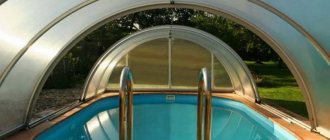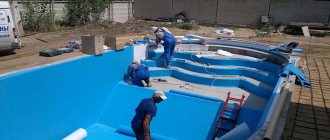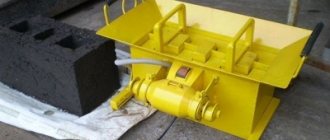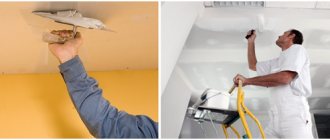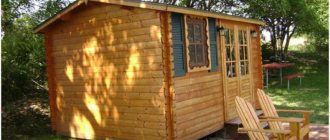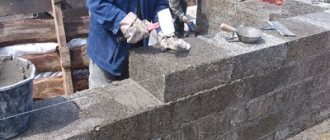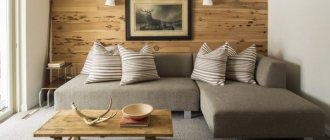Choosing a bathhouse construction site
But before you begin construction, you need to complete a number of preparatory measures that will protect you from mistakes and problems in the future. First of all, this is the place where the foam block bathhouse was built. To do this, you must choose a foam block bathhouse project or at least decide on the basic dimensions of your building.
When choosing a site for construction, you should be guided by the following parameters:
- Choose a construction site that is not too far from the house or main communications;
- If the bathhouse is supposed to have a swimming pool, then it is better to place it on a hill . This is due to the fact that a fairly deep pit will be required to construct a pool. And for high-quality water drainage, you will need to have at least a minimum slope of the water drainage system.
- Do not locate the building above laid water supply or drainage networks . If they break, this can lead to serious problems associated with their repair;
- Your projects for building a bathhouse made of foam blocks should take into account the inadmissibility of construction near gas pipelines . So, according to SP 62.13330.2011, the minimum permissible distance to the building should be 2 meters for low pressure pipelines and 4 meters for medium pressure;
- Also, the building should not be located near power lines . So, according to the PUE, the distance from the house to the power line with voltage up to 20 kV should be at least 2 meters. For cable lines of all voltage classes this distance is the same.
Design
First of all, before you start building a pool, you should develop an appropriate plan. It will allow you to theoretically evaluate the possibility of constructing a given architectural object, as well as preliminary calculate the estimate for this process. If you don’t have at least an approximate diagram, you shouldn’t start taking any action to implement the idea.
The following details should be considered:
- It is necessary to determine how many people will use the pool at the same time.
- You need to think about the overall dimensions of the future object: width, depth and length. It is also worth determining the shape of the bowl. It is believed that the most optimal area is between 25 and 40 square meters. In this case, the depth should be from 1.5 to 2 meters.
- The thickness of the bottom and walls should also be thought out in advance. It should be influenced by the types of soil, the depth of groundwater, the depth of the structure, etc. The worse the soil quality, the more significant the walls should be. This also applies to the base - the deeper the bowl, the more reliable it should be.
Pool design in 3D - A communication scheme should also be developed. It must indicate the sewer system, the location of all filters used, the skimmer, stairs for entry and exit, as well as lighting, if provided.
- Special attention should be paid to methods of emergency and planned water discharge.
As soon as all the above nuances are thought out in the plan, you can immediately begin to carry out the work.
Advantages of a concrete pool
The main advantage of a monolithic concrete pool over prefabricated structures is its longer service life. If we compare pools in terms of strength, then concrete structures outperform all other types. They can even be installed outdoors.
Concrete is easy to finish, which allows you to decorate the pond in accordance with the wishes of the owner. The role of finishing material can be played by mosaic, decorative plaster, tiles, etc. In addition, the cost of constructing a simple concrete pool is significantly less than the cost of a finished product made from composite materials that are popular today.
Reinforcement
Reinforcing the bottom of the pool is a mandatory step. In this case, the height of the concrete layer should be about 20 centimeters.
In the reinforcement process, ribbed reinforcement is used. Its cross-section should directly depend on the operating conditions of the pool. But the diameter should not be less than 12 millimeters. The spacing of the twigs should be 20x20 or 30x30 centimeters. It can be equipped with one or two belts. The second option is often chosen in the presence of soil heaving forces.
NOTE! The reinforcement should be recessed into the concrete by 5 centimeters. That is why it is laid on bricks, which give the desired size. The distance between layers should be 10 centimeters.
Installation of a swimming pool made of concrete blocks
This method is very similar to working with polystyrene foam blocks, but concrete also has its advantages. It is durable and easy to install, and the small size of the material allows you to create a bowl of the required shape and make beautiful steps.
In this option, the main thing is to correctly lay out the blocks using concrete mortar and seal the surface well before facing. The advantage of concrete is that ceramics and artificial facing stone are perfectly placed on it. You can also do the work of decorating the pool yourself.
Preparing the base
It is worth constructing a cushion under the pool because in this case concreting will be much easier. In addition, such a base allows you to extend the life of the object. The backfill under the pool bowl should be made of sand and crushed stone. This mixture must be spread evenly along the bottom of the pit and compacted thoroughly. Its height should be between 25 and 35 centimeters.
To waterproof the bottom, you can use polyvinyl chloride (PVC), bitumen or roofing felt. These materials are lined in one or several layers. Be sure to lay them with an overlap of at least 15 centimeters. The edges of the materials need to be placed on the walls of the pit.
DIY pool made of concrete or polystyrene blocks
Expanded polystyrene is a lightweight and easy-to-use material. A homemade pool is made from the largest blocks. This way you can quickly build a pond and a Roman staircase.
Step-by-step guide to building a pool using polystyrene foam blocks:
- Excavation work - digging a pit. The length of the pit should be 50 cm longer. The bottom is filled with crushed stone and compacted.
- Filling the bottom of the pool. First, the reinforcement is installed. Metal rods are inserted and tied together using thick wire. Next, concrete is poured and the surface is leveled.
- After the concrete has hardened, waterproofing is carried out using agrofibre. Next, a polystyrene foam pillow is installed. To connect materials, use paper clips or construction tape.
- Bowl installation. Blocks are laid. The material is easy to work with; if necessary, you can cut the polystyrene foam with a hacksaw. Each block is equipped with grooves for joints, thanks to which the material adheres to each other.
- Drain installation. All pipes are removed and filtration equipment is installed.
- Strengthening and lining of the structure. To do this, metal rods, stairs and facing tiles are inserted.
Often, concrete blocks are used to build a swimming pool. The installation technology is similar to the installation of polystyrene foam material. The blocks are secured using concrete mortar.
For structural reliability, every third layer of blocks is reinforced.
After the structure has hardened, the bowl is covered with film. It is secured around the edges and the pool is filled with water. This is how the polyethylene is leveled. Next, finishing begins. All work can be easily done with your own hands.
Plastic liner lined with brick
Here the situation is simple. Buy a plastic liner for the pool. They are inexpensive and come in different sizes and shapes.
Even when purchasing, consider how the water will be drained - from below, through the bottom drain, from the sides, through nozzles, or over the edge - with a skimmer. Lay pipes according to the type of water drainage when preparing the foundation for the pool.
Installation on the ground
After you have brought the bowl to the site, prepare a flat area for it. It will be necessary to remove the fertile layer of soil with vegetation and make bedding according to all the rules - as described above.
A plastic liner lined with brick is an excellent option for a pool or bathhouse and more
When draining water from the pool at the bottom, it is advisable to make a pit where the pipe should be led out. Equipment can also be located here - pump, filter, etc. With a screamer and a side drain, the pump will in any case be below the water level, so everything is organized more simply here.
Sometimes the liner is placed directly on the sand, sometimes a podium is laid out from the same brick, and the bowl is placed on it. It all depends on the type of soil. If they are not heaving, then you can put them on sand, but on clay and loam soils you will have to make at least some kind of foundation.
If you want, you can lay polystyrene foam under the brick (or on it) - there is no such thing as excess thermal insulation. You can also cover the sides of the bowl with this material, and only then cover it with brick. Great thickness is not needed - 3-5 cm is enough.
Another option for a brick-plastic pool
The waterproofing and rigidity of the walls is ensured by the liner, so there are no special requirements for the masonry and its finishing. Do as you please.
Recessed installation
The liner can be partially buried in the ground. With this option, only the depth of the pit changes. After installing the bowl (with or without thermal insulation - decide for yourself), you will need to fill the gap between the wall of the pool and the pit. This can be previously removed soil, gravel or sand.
Gravel and sand are an option for heaving soil, excavated soil is an option for normal soil. You compact the backfill and begin to cover the protruding part with bricks. Actually, that's all - finishing work remains.
Wood-fired sauna with pool
Why is a wood-burning bathhouse so popular now? After all, you can heat with other fuel... Check out the benefits of a wood-burning sauna:
- You don't have to save money;
- A wood stove heats stones faster;
- This is an environmentally friendly fuel.
Having built a turnkey sauna from a log with his own hands, the owner “risks” giving himself and his loved ones an unforgettable experience from the smell of natural wood and a luxurious feeling of comfort from thoroughly warming up the body in the steam of the sauna.
And if, after warming up in the bathhouse, you have the opportunity to immediately move into a cool pool with a large volume of water and enjoy swimming, then you can significantly strengthen yourself and improve your health. A house that has a bathhouse with a swimming pool and a large billiard table in one of the rooms will become warm and hospitable for a large family or a group of loved ones.
Of course, a sauna with a swimming pool will be an excellent opportunity to relax at the dacha or in a country house.
What is it for?
When ordering the construction of swimming pools for their dachas, people, first of all, want to add comfort to their dacha holiday. It’s no secret that today growing garden crops is, first of all, not a way to provide yourself with food, but an active recreation that allows you to forget about problems at work, the bustle of the city and get as close to nature as possible. And such a vacation is doubly pleasant if you have the opportunity to swim after useful work or simply lie down next to the surface of the water in a sun lounger.
What to consider at the very beginning
Before finding out how much it costs to build a pool on a turnkey plot, you need to analyze a number of points that directly affect the cost of the pool:
- what will be the functional purpose of the pool
(decorative, children's, for adults);
An inflatable children's pool is the most inexpensive and simplest option for a summer cottage.
- will it be stationary or collapsible
pool;
- opportunity deepening the structure
in terms of groundwater levels;
- how will it be organized drain system
and water treatment;
- how much is free area
, suitable for placing
a tank
; - which form
will be at
the bowl
.
Stationary or prefabricated
The type and size of the pool directly determines how much it costs to build a turnkey pool on a site. Permanent structures tend to be more expensive than comparable sized prefabricated bathing tanks.
In addition, maintenance and operation of collection tanks will require less money. It should be understood that if the pool is being installed for a long time and will be used frequently, then you will have to invest in a stationary structure. If you need it for short-term use on a small summer cottage area, then you can get by with a prefabricated pool.
Inflatable structures can be quite large in size, sufficient for bathing adults and children.
Non-stationary structures
These types of bowls are small or medium in size. Depending on the characteristics of the selected type of pool and the option of installing equipment (on the surface or with recess), the installation time of the structure can range from several hours to three days. There are the following main types of collapsible bowls for a summer cottage:
- rod frame
;
- sectional frame
(plastic, metal, wood);
- inflatable
.
If you need the most economical option, then it is easier to buy a ready-made inflatable bowl than to make a pool at your dacha. Its price is minimal and ranges from 2 to 16 thousand rubles. The diameter of the inflatable bowls does not exceed 5 meters, and the depth ranges from 50 cm to 120 cm. They are made of PVC film; for large-sized products, the structure is reinforced with a frame of thin-walled aluminum tubes.
Large inflatable bathing tanks may have additional supporting sides of the structure.
Some models are equipped with filters for water purification. The small volumes of the bowl allow the water in it to quickly heat up to ambient temperature. The weaknesses of inflatable products are:
- high risk of mechanical damage
due to a puncture or cut;
- the need to resolve the issue storing the bowl in winter
;
- exposure to negative influences ultraviolet
which can cause
PVC to crack
.
The next in increasing cost are prefabricated rod products. On average you will need to pay from 4 to 20 thousand rubles for them. The frame in them is a structure of vertical and horizontal posts with special fastenings. The water is retained by a PVC cover; these pools are supplied with a pump equipped with a filter. The weaknesses of rod frame tanks are the same as those of inflatable products.
To install a rod frame bowl, you need a flat base and 2-3 hours of installer work.
Sectional frame products or rigid frame pools are among the most reliable prefabricated structures. Metal, plastic or specially treated wooden elements are connected by locking, bolting or gluing. The depth of such bowls ranges from 1.2 to 2.4 meters.
Their advantage is the absence of the need for dismantling during the cold season. It is enough to simply remove the polyvinyl chloride tension element. A typical pool kit includes a pump with a water filtration unit and a skimmer (cleaning device). The average cost of frame products ranges from 40 to 100 thousand rubles.
Sectional frame pools are similar in performance to stationary bowls.
Stationary
Stationary pools are made from various materials, this in turn affects the cost of constructing the pool and its operational properties. In particular, bowls are made from:
- concrete
;
- red ceramic brick
(walls) and
concrete
(base); - metal
;
- multilayer
(composite)
fiberglass
; - polypropylene
.
Examples and descriptions of projects
The price for a bathhouse project with a pool made of foam blocks will not always be high. You can build a spacious two-story house with a large tank. The cost of such a complex is not suitable for everyone, but you can also install a small bathhouse with a font inside.
This option will fit perfectly into the style of the summer cottage. The construction of a bathhouse with an external or internal pool is more difficult to complete, but this rarely stops lovers of water procedures.
Projects for a bathhouse with a pool made of foam blocks include several main rooms:
- Waiting room;
- Steam room;
- Wash compartment;
- Pool;
- Restroom.
There are many interesting options for equipping such recreation complexes:
- You can also place a small kitchen and bathroom here.
- A good solution would be to use the space under the roof. In the attic there are recreation rooms, a billiard room, and a guest room.
- A veranda or terrace is often attached to a building. They are performed open or closed. You can install a stationary stove or a simple grill on them.
It is best to place a water reservoir next to the steam room. For outdoor options - next to the entrance to the bathhouse. A project for a bathhouse made of foam blocks with a swimming pool can be purchased ready-made, or you can make the drawings yourself.
Important! If the option of an internal tank is chosen, then a place for it must be provided immediately. It will be difficult to convert everything in the completed building to accommodate a swimming pool.
Walling
In most cases, walls are built in one row of blocks. Due to the fact that these products are quite massive, they can easily withstand the mass of water that will be in the pool.
The first two layers of blocks must be laid on ordinary concrete mortar with water-repellent properties. As for the third row, it is best to reinforce it. This sequence must be continued until the construction of the wall is completed.
The reinforcement can allow the blocks to gain greater rigidity and resistance to the mass of water in the pool. That is why other methods for constructing walls of hydraulic structures of this type do not exist.
Insulation
In order to reduce the financial costs of heating water in the pool, it needs to be insulated after waterproofing work has been carried out. It is important to understand that heating several tons of water by 1 degree will require quite a lot of electricity. Due to the fact that this structure is buried in the ground, the sun will have minimal influence on it.
For thermal insulation, builders recommend using foamed polystyrene. It performs its main function well and does not absorb water. In addition, various microorganisms do not multiply in such material. Polystyrene is not eaten by insects, so it cannot be damaged in this way.
It is worth noting that it is best to choose high-density thermal insulation material. This figure must exceed 35 kilograms per square meter.
NOTE! Installation of polystyrene should be carried out in two layers. It is necessary to lay it in such a way that it overlaps the joints of each other. Additionally, water-repellent mastic should be applied to the seams.
Defining parameters
There are no special conditions for the size of the reservoir; a lot here depends on the preferences of the person and the capabilities of your summer cottage. So, if you have a lot of space in your dacha, then it is better to build a large metal frame pool with your own hands; if it is not much, then it is advisable to build a small one! So, for example, a small tank can be built in the following dimensions: approximately 5 meters in length and 2.5 meters in width, if larger, then the width can be doubled. When choosing a depth, you need to understand who will most often be in it - children, adults, or both. If you have children, then it is better to build a shallow “paddling pool”. For older children and adults, a pond with a depth of no more than 1.4 meters is suitable. It will be comfortable for both children and adults.
Other Important Details
The recess around the perimeter of the pool can be filled in various ways. For this purpose, soil dug during the construction of the pit is often used. But in cases where the soil is quite heaving, crushed stone can be used. It needs to be poured into the hole and compacted quite firmly.
On top of the perimeter of the pool, you can fill it over crushed stone, on top of which you should lay a tiled covering. It is best to use a material with a matte surface. This will increase the level of safety near this hydraulic facility.
Preparatory process
As an example, let's consider the most cost-effective project that will require only your skills and strength - a pit pool with a steel base.
Before starting construction, you must have tools and building materials, as well as fittings and, of course, a steel pool design approved by specialists. Prepare:
- Ruberoid.
- Concrete grade M350-M400, frost resistance index F200, water resistance W6.
- Cement grade 400.
- Sand of medium granulation.
- Fiber fiber.
- Plasticizer.
- Reinforcement (steel, rigid - rolled I-beams, channels, angles, flexible - individual bars of smooth and periodic profile, welded or knitted meshes and frames). For the formwork and the area around the pool, reinforcement of wood origin (bamboo) is suitable.
The following tools should be available:
- Master OK.
- Meter.
- Level and plumb.
- Shovel.
- Construction tape.
- Sharp knife.
- Hacksaw.
- Container for mixing concrete.
- Construction mixer.
- Welding machine.
